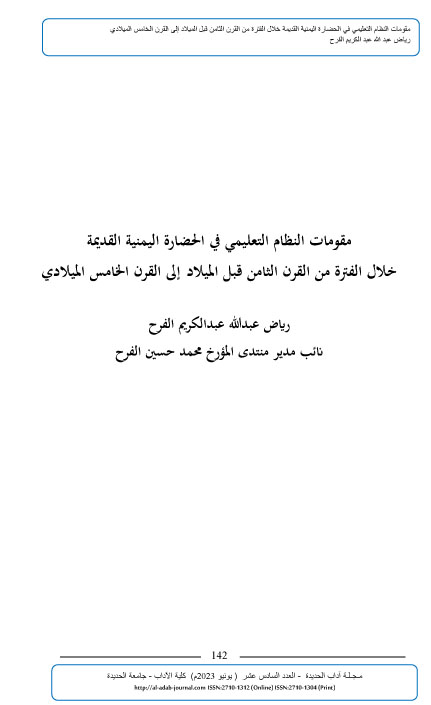Components of the educational system in ancient Yemeni civilization During the period from the eighth century BC to the fifth century AD
Abstract
Education is one of the most important components of civilization that humanity has known throughout its long history, and it is the basis of evolution and development. It is described as a social activity in which knowledge is transferred from the teacher to the learner. Education is also one of the products of societal education and the study of the process or stages of education that man has known throughout the eras of time. The stages of his development take us to a broad concept of the meaning of education, as each stage of human development has its own characteristics, characteristics, and needs as well. In the stage of primitive man, who knew the life of hunting and hunting, he did not need more than knowing how to meet his basic needs, and education required a type of Education is education by imitation, and with its transition to the life of agriculture and the knowledge of sedentary life, another type of education arose in which the need necessitated the education of members of society to learn production and learn to manufacture their needs for the materials they use in plowing the land and irrigation tools and developing them. This is the stage in which handicrafts were the basis for the establishment of society. The development and growth of society arose the need for a means of communication with its vast surroundings and with other societies, and here writing appeared, and with its appearance, human civilization began to take on its features, and human life began to take on new aspects that pre-writing man did not know, and the period before the invention of writing was known to those studying human history. The period after the emergence of writing was known as the historical period, which coincided with the emergence of architecture, the construction of dams, temples, and palaces, the movement of advanced trade and industry, and other features. Writing became at the forefront of human interest in recording his knowledge and documenting his laws, according to which society and its relationships are organized. With home and abroad, the ancient civilizations that arose in Mesopotamia and Egypt were known for advanced models of community education and places of education that were revealed through archaeological studies and excavations. In ancient Yemen, a civilization arose that reached the height of its power in the Kingdom of Sheba, Ma’in, Qataban, Awsan, Hadhramaut, and Himyar, a civilization no less It is more important than other contemporary civilizations in Mesopotamia and Egypt, and their effects still remain in many parts of Yemen. Their exploits were mentioned in the writings of the Greeks and Romans and the inscriptions of contemporary civilizations. These cultural monuments in ancient Yemen coincided with the growth of knowledge, writing, sculpture, and social education, as any civilizational growth does not... Education must be its key and main entrance. It is not reasonable for a civilization to arise in ancient Yemen without there being advanced education to keep pace with that progress and the desire of the researcher to shed light on this topic. He raised several questions or hypotheses and we were able to answer them in the context of this search

